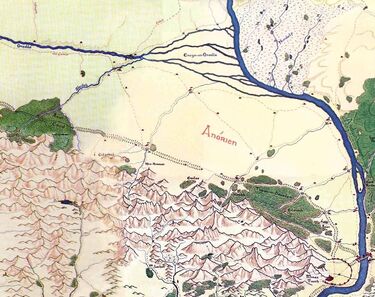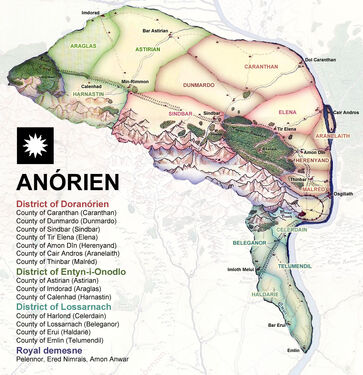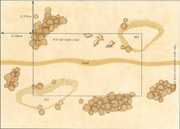
Anórien was the original personal demesne of Anárion in Gondor, and after him the royal demesne of his heirs, the Kings of Gondor. Founded in S.A. 3320, and lasting into the Fourth Age, located between the White Mountains, Glanhír, Onodló, Anduin, and Erui.
Names:
- Land of Anárion
- Land of the Sun
- Sun-land
- Sunlending
Anórien in T.A. 1640-1650[]

- Political Organization: Province: Royal Fief administered by the Prince-President of Minas Anor.
- Rulers: King Tarondor of Gondor; Vinyaran, Chief Councilor and Commander; Belatar, Helm-prince and Commander; Mindacil, Prince-President of Minas Anor.
- Administrative Organization: The King has absolute authority within his home province, but he leaves the details of administration to his staff, drawn from his family and members of the nobility. Most land in Anórien is held by the King and distributed in fief, some possessed directly by nine noble houses.
- Population: 70.000 Dúnedain of the South.
- Military: 240 Royal City Guard, under the Prince-President of Minas Anor; 400 City Militiamen under the Prince-President; 1,200 Regular foot-soldiers under the King's Commander.
- Products: Marble, finished products, trade, government.
“Anórien [in T.A. 1640] was the fast-rising star of the Gondorian realm. While the Ship-kings reigned in Gondor, little thought was given to the lands up-river from Pelargir. Gondorian authority extended beyond Osgiliath and Minas Anor, but it was the coastal provinces which reigned supreme. After the Great Plague, the downfall of Osgiliath, and the ravages of the Corsairs, the focus of Gondorian power shifted inland. King Tarondor moved his primary residence from the port city of Osgiliath to the more secure fastness of Minas Anor. Control of the seas remained absolutely vital to the Gondorian economy, but the focus of Gondorian leadership had moved from aggressive expansion to cautious consolidation and defense. For this role, Anórien and its chief city seemed perfect.”[1]
The importance of Anórien in controlling the northern territories of Gondor has long been understood by the descendants of Elendil. A series of beacon towers relayed messages between Gondor's capital and the plains of the Onodló. The High-king himself chose the northern slopes of the White Mountains as his final resting place, where he remains undisturbed in a simple grave marked by an unimposing stone (on Amon Anwar)[2]. In the mid-Third Age, Anórien serves as a link between the sea-provinces and the inland territories. Without the security of Anórien, the whole realm would surely collapse.
Anórien is a fertile province long considered the grain-basket of Gondor, tucked around the eastern tip of the White Mountains. With the shift of the royal residence to Minas Anor, Anórien now finds itself a political center as well. The change has brought a wealth of trade to Minas Anor, which is more than delighted to take on the new role as a mercantile center. The enhanced status of Anórien has also meant that it has received more than its share of refugees from the Plague. These dispossessed have become a burden to the city folk who are themselves pressed for resources in difficult times. Anórien now finds itself an importer of grain from the distant reaches of Calenardhon and Dor Rhúnen.
The foothills of the White Mountains are famous for the high-quality marble which they produce. Marble blocks quarried in Anórien are reputed to be the building material out of which Gondor was hewn, a story with more than a grain of truth to it. Industry is well established in Minas Anor, a city second in size only to Pelargir. The workshops and Fellowships of Minas Anor produce splendid items which then travel to every corner of Middle-earth. Not only does Minas Anor send its products to other lands, but it receives a vast share of the trade entering Gondor. The city guards the juncture of several trade routes, and it benefits immeasurably from its location. The Anduin, the highway to the north, becomes a sea-avenue to the lands of Far Harad where the river broadens just past the decrepit Osgiliath Bridge. All traffic north of the White Mountains on the Old North Road, the main artery of communication with Arthedain and Cardolan, passes through Minas Anor. South of the city, the road swings abruptly south and west, becoming the Men Gondor, linking Anórien to Gondor's most populous provinces. Across the Anduin, there is easy access to the roads of the East, which link the Gondorian province of Ithilien to territories in Rhovanion and the land route to Harad.
The King keeps a fairly small army stationed in Gondor's central province. Large forces in Ithilien, Lebennin and Calenardhon make a sizable garrison in Anórien unnecessary. Apart from the small contingent of the elite Royal City Guards, most of the troops around Anórien are recruits, receiving their training before they are sent to Gondor's borders to protect the kingdom. Minas Anor also maintains a City Militia, a volunteer force which preserves order within the city walls.
For all its newfound importance, Anórien remains a conservative agricultural region. Just a few bow-shots away from Gondor's most important city, farmers quietly go about their business as they have done for centuries. The farmers who have always tilled Anórien's soil look upon the new governmental and mercantile traffic with suspicion. A few of the more outspoken agriculturalists have hinted at open defiance if the King cannot find some way to restore calm to a formerly placid land now troubled by refugees and the affairs of state.
Regions and Rivers[]
Anduin Aron Ered Beaconmarches Beacon Hills Cair Andros Drúadan Forest Eneyn-in-Onodló Erui Eryn Cordovath Eryn Mith Far Anórien Firienholt Forant River Glanhír Grey Wood Lossarnach Old Anórien Onodló Pelennor Siriath Stonewain Valley Talath Anór Tumladen (Gondor)
Settlements and Points of Interest[]
Amon Dín Amon Hen Amon Lhaw Bar Fordelin Bâr Nadhron Cair Andros Calenhad Calost Causeway Forts Dúneth's Camp Drû Bhûta Crithost Eastern Blockade Eilenach Erelas Fordelin's Manor Halifirien Harlond Hillock Jal Kepir Jal Vârsha Luk Kakhát Maudhul Grak Minas Anor/Minas Tirith Min-Rimmon Rimmon-Quarry Nardol Nardol Quarry Nelheneb Silvermines Osgiliath Ost Rimmon Parth Duin Parth Forant Parth Gladló Parth Lisc Pel Chardún Pel Dúven Pel Enaid Pel Forod Pel Tundalaf Rammas Echor Rauros Théoden's War-Stead War-stead of the Eorlingas war-stead of the Helmingas
Characters[]
ca. T.A. 1640-1650[]
King Tarondor of Gondor; Vinyaran, Chief Councilor and Commander; Belatar, Helm-prince and Commander; Mindacil, Prince-President of Minas Anor Grathian, Famous Highwayman
ca. T.A. 3018-3019[]

Amegil Andothol Baldeg Barathand Bargwen Bhai-buri-Ghân Bregdal Brúnion Burnoth Cangrail Crúmgam Dringrod Ganglemód Ghân-buri-Ghân Gúthrakh Hengest Hirgon Huntha Khôr-buri-Ghân Krûghu Lacheg Léofdag Malhar Mân-weni-Mhên Narvagol Naurúk Shákrug Sithgar Togbor Tolwin Ulf the Reaver Wêg-pulo-Ghûr Witherbreca
References[]
- ↑ merp.com/wiki/Anorien (archived, latest available)
- ↑ Later, sometime (apparently) shortly after the grant of Calenardhon to the Éothéod by Steward Cirion, Elendil's remains were removed to the Hallows of Minas Tirith.
